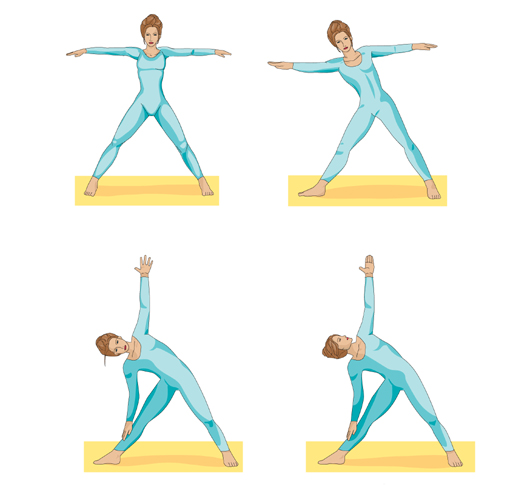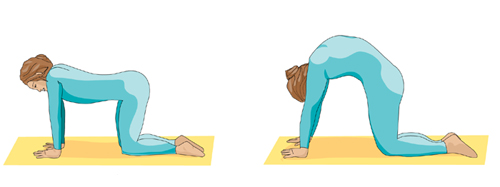|
|
||
|
Home |
Best Abs Book |
Best Ab Exercises |
Abdominal Ball Exercises |
Abs Exercise Tips |
Abs for Sports |
Pregnancy & Abs |
Yoga |
Pilates |
Flat Stomach Diet |
Smoothie Recipes |
Weight Loss Stories |
Lose 10 Pounds |
Lower Back Pain |
Back Stretching Exercise |
Resources |
Free Calculators |
Site Map |
About
Free Yoga Positions - In Standing, Sitting and Prone!
Yoga standing posesSome of the most efficient poses are the standing positions. They offer excellent stretching of the muscles and they have noticeable effects on the nervous system. Most standing poses help to improve your posture. In the following paragraphs we will have a look at a few of the standing poses. The mountain pose (known as the Tadasana) got its name from several defining attributes that share the symbols of the mountain. Much like a mountain, the person practicing this pose will be surrounded by stillness and will feel a pronounced sensation of balance and posture. The mountain pose is achieved by keeping the heels slightly apart, so that toes are parallel. Perform a back and forth rocking motion on your toes and gradually come to a complete stop. Lift the ankles in order to consolidate the pose while also tightening the leg muscles. Push your tailbone towards the floor while lifting your pelvic area towards the navel. Your arms should be hanging near your body while you are pressing your shoulder blades backwards. The mountain pose is the basis of many other poses. Tadasana implies that the practicing yogi has to learn the meaning of balance and stillness before moving further. For this reason, the mountain pose is one of the best ways to connect with your inner feelings while learning the subtle ways of yoga. The standing forward bend pose starts in the mountain pose an dthen you slowly stretch your arms overhead with your palms facing forward. Gently bend forward as you exhale and stretch only as far as your your knee and abdomen will allow at a comfortable level. Place your fingers or hands on the floor if able or on each side of your feet and move your head toward your knees, breathing into the position. Exhale as you reverse this position to stand up. The next standing pose is the Triangle pose, or the Trikonasana. This pose has a good stretching effect on the back, legs and hip muscles. Keeping your knees straight but not locked is important while performing this pose, as this will allow your movements to be fluent and to stretch all the targeted muscles and organs. In order to enjoy the full benefit of the triangle pose you should position your body correctly. Your feet should be spread apart about 3-4 feet. Inhale and stretch your arms to the sides. As you exhale, stretch your right arm upward over to the left side of your body and place your left palm against your leg for stability. Turn your head and look upward toward the stretched right arm. Stretch only as far as is comfortable for you and be careful not to bend forward at your hips. Inhale as you come back to the center and repeat on the other side.
Yoga Seated PosesThe succession of poses is important in yoga, as each preceding pose prepares the body for the next level of intensity. The seated poses work best when started with the Sukhasana, a very easy pose that allows the body to adapt to the higher demands of the following positions. Sitting in Sukhasana has positive effects on the neck muscles. Try doing Pranayama and other exercises such as neck or eye movements for improved coordination and overall flexibility. Make sure to warm up your body before attempting these poses and do every movement in a gentle and controlled manner, for best results. Sukhasana, or easy pose, is an excellent pose for meditation, helping yogis maintain a straight spinal position that has positive effects on posture even after the yoga exercise is over. The leg position should alternate in this posture so that none of the muscles get cramps. While on the floor and with your knees bent, try to hold them with your arms while gently pulling them towards the chest. After you feel the muscles being stretched you can release your legs and cross them while your knees get closer to the floor. The next pose is the Virasana, also referred to as the kneeling pose. Get into a kneeling position on both keens and sit back on your heels. This pose should be avoided if you have problems with your knees. While you are sitting, try to keep your back straight by drawing the abdomen inwards. In the Virasana your hands may rest on your knees or thighs. Prone Yoga PosesIt is always a good idea to begin a series of poses with some easy, warm up positions. The single leg raise is a good way to start the session and prepare yourself for the following asanas. Leg raises are great for toning your back and abdominal muscles. In order to effectively do this movement you should keep your back "glued" to the floor and not allow your back to bend or your shoulders to help in the lifting motion. With palms resting on the floor, try to raise your legs slowly, while keeping control. The neck should remain relaxed during this motion and your lungs should be allowed to breathe freely. The following exercise aimed at improving your leg muscles and flexibility is the leg-pull. This is great for a complete stretch of the leg muscles, which, in time, will grant you the ability to perform advanced yoga postures. While down on the floor try to catch your foot, while your leg is sitting straight above your head. If reaching your foot is a problem try using a belt to help you out. With the leg kept constantly straight, try to point your heel towards the ceiling. Gently pull the leg closer to your body while keeping your back straight and your shoulders close to the floor. Now slide your other leg on the floor, keeping it straightened and roll your thigh until your kneecap is directed towards the ceiling. With your shoulders still flat press your feet away from you, spreading them while you are pulling the raised leg towards you. Breath and movement control is essential in all yoga poses, and the Bidalasana is a great exercise to help you get ready. Also known as the Cat Pose, this technique improves coordination and balance. Your center of gravity is closely related to your pelvic area in relationship to the rest of your body. In the cat pose, you are on your hands and knees allowing your back to arch upward and downward. You should allow your head to follow the motion as well. A great benefit of these poses is they teach you your muscles how to hold yourself in good posture for your back. Certain poses, such as the leg pull, for example, may seem a bit too demanding at first, so don't get discouraged if you are unable to follow the instructions completely on the first attempt.
Return from Free Yoga Positions to Abs Exercise Advice Homepage
Home |
Best Abs Book |
Best Ab Exercises |
Abdominal Ball Exercises |
Abs Exercise Tips |
Abs for Sports |
Pregnancy & Abs |
Yoga |
Pilates |
Flat Stomach Diet |
Smoothie Recipes |
Weight Loss Stories |
Lose 10 Pounds |
Lower Back Pain |
Back Stretching Exercise |
Resources |
Free Calculators |
Site Map |
About
|
Download 21 Free Abs ExercisesEnter your name and email address here to get your free download: The ABS Lady Recommends: |
|
|
|
||
|
Best Abs Book | Contact | Disclaimer | Privacy Policy Copyright © 2004-2013 Abs-Exercise-Advice.com - All Rights Reserved. Return to top |
||

